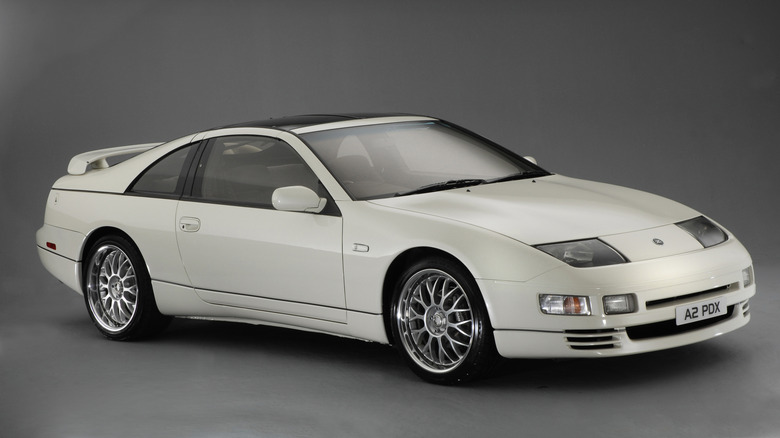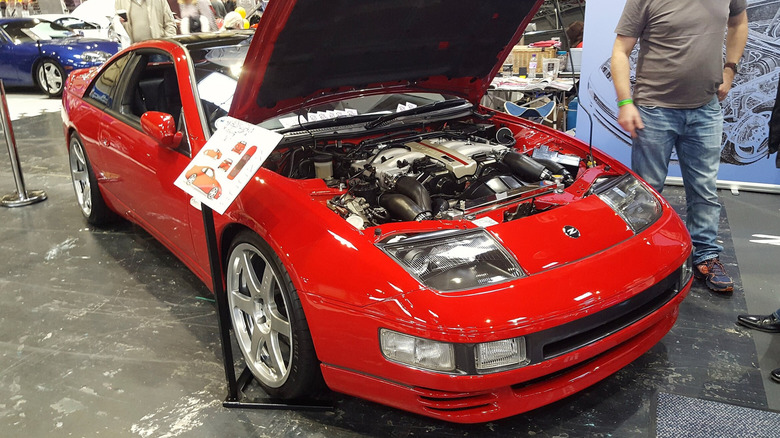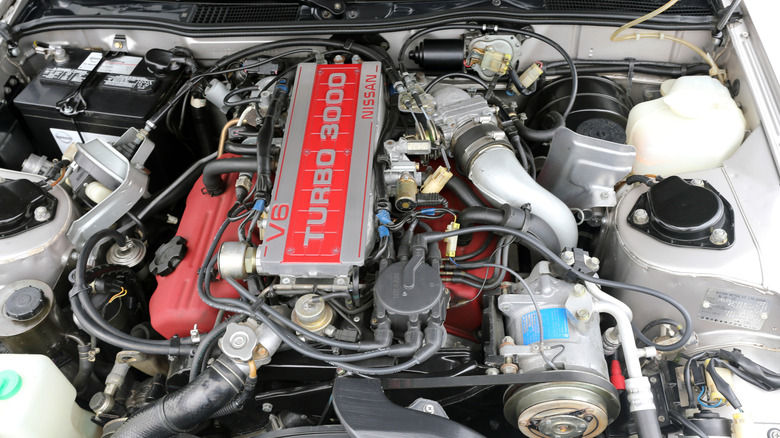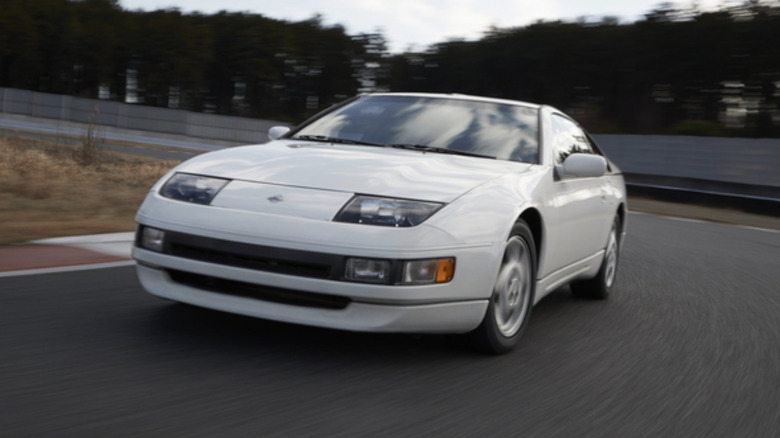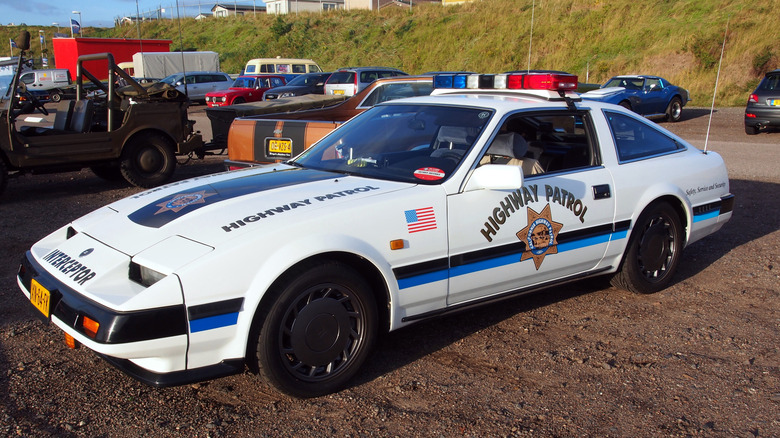Common Problems With The Nissan 300ZX (According To Owners)
We may receive a commission on purchases made from links.
It's often said that the 300ZX "rescued" the entire Z-line of Nissans. Not only was it especially popular during its second-gen production from 1990 to 1996, but it's since become one of the most coveted sports cars for tinkerers that want a cool project car. In fact, after over 25 years since its discontinuation, the average price for a used 300ZX is still competitive. This is because the speedy racer maintains a high position on rankings like the most important Nissans of all time and the top classic cars that make for great investments.
Yet for all the praise given to the 300ZX, it's certainly not without weaknesses. The design team's original concept clashed with engineering limitations, and the resulting product was notoriously cramped under the hood. The densely-packed engine bay was just the tip of the iceberg, and the first of several qualities of the 300ZX that you should know about before buying one. But not all of its "quirks" are bad things. To get a good idea of the problems surrounding the 300ZX, we'll have to look at actual owners' complaints.
Many of the 300ZX's problems are the result of the longevity of its mechanical parts, such as fuel injector failures and melted wire harnesses. In other words, they're issues that can be fixed. Nonetheless, it's important to keep these specific "areas of interest" in the back of your mind when shopping around or maintaining your 300ZX, so let's review the reviews.
A near-guaranteed need to replace the fuel injectors
Any online discussion about problems with the 300ZX almost always mentions the shockingly-high failure rate of the fuel injectors. Fortunately, replacement injectors are relatively cheap, with 270cc Fuel Injectors for 1993 to 1996 models costing $100. You might even be able to clean the old ones to get more use out of them. Nonetheless, the commonness of fuel injector problems means it shouldn't be ignored.
For example, on a ZCar.com thread about potential problems with the 300ZW, one commenter didn't exactly mince their words when criticizing the fuel injectors. "Assume you will need new fuel injectors... the worst it ever ran was when one of those **** injectors went bad, causing an annoying miss." Similar complaints abound elsewhere. Another owner from RepairPal, said, "injector #2 failed, replaced fuel rail and injectors... then #3 failed right away." Another wrote, "Installed new fuel injector plugs... and now running on all cylinders again." And one unlucky customer said, "cylinder injector had to be replaced... Car now has about 80K miles and the same cylinder injector has gone bad... Replaced injector again but this time engine noises."
Problems with the fuel injectors are so common on 300ZX that it's become the vehicle's most-reported issue on RepairPal. All seven model years from the second generation, from 1990 to 1996, are listed on the site's problem page. RepairPal concludes that the "Fuel Injectors May Fail and Cause Drivability Concerns on Nissan 300ZX." A total of 21 people reported this problem. "Drivability concerns" could mean any of the six main symptoms of fuel injector failure, such as engine misfires, a poor overall performance, and the smell of fuel inside the car.
An engine that's tricky and expensive to work on
The cramped layout of the 300ZX's engine bay is something of a "quirk," but it's a quirk that can't be fixed — you'll just have to live with it. In fact, the gaps between the different engine components are so tight that even the skilled mechanics lament the great difficulty involved in working in and around it.
For example, in a Reddit thread asking about potential problems with the 1990 300ZX, the exact same sentiment was shared by multiple commenters. One said that the second-gen 300ZX models, "are difficult to work on (engine wise)," another that, "they are fun, reliable and beautiful but they are quite difficult to work on," and another wrote that the, "cramped engine bay make them difficult to work on."
Clearly, there's a common theme here. But the tightly-packed engine bay isn't the only thing that makes the 300ZX a daunting project car. The high costs in fixing one up also present a big challenge. For instance, one owner pointed out how difficult and expensive it is to find the stock paints, saying, "The stock Pearl coat is extremely hard to match... to match the Pearl coat properly, I had to paint 2/3 of the car and pay about $3K." Another owner decried the high cost of replacement parts, writing, "parts are priced as if they are hone out of rhino horn."
Thus, working on this Nissan sports car is a pricey endeavor, even for those willing to take on the 300ZX's frustratingly cramped engine bay on their own.
A fuel economy that falls below the already-awful estimates
This is another common complaint that can't be fixed. The abysmal fuel economy of the 300ZX is a major drawback for an otherwise well-received and impressive design. To add insult to injury, many owner reviews actually claim that they get even fewer miles-to-the-gallon than the official mileage claims. In other words, these cars are gas-guzzlers on paper and even worse gas-guzzlers on the road.
Consider owner reviews of the first model in the second generation of the 300ZX. This 1990 model was met with acclaim, with one owner writing that, "This thing handles like no other car I've owned — put a set of sticky tires on it... and I'm in hog heaven." However, the same commenter went on to say, "the advertised mileage for it, in my case at least, is a bit low."
Other reviews aren't as kind. On another forum, one owner claimed they got 13 mpg driving in the city, another reported 15 mpg, and a third said they can only get a combined 20 mpg if they "baby it." An owner of the 1992 model wrote that their fuel consumption "seems very high." According to FuelEconomy.gov, the original 1990 manual 300ZX could expect a combined mileage of 18 mpg. Later years barely improved that number, with the 1996 manual model bumping up its combined mileage to just 19 mpg. The 300ZX's official fuel economy is low, but this doesn't come as a surprise. It's a sports car, after all, but reviewers still lament it anyway.
Some parts are fast to wear, tear, and melt
This common issue goes hand-in-hand with the "cramped" engine bay. When components are so closely packed together, heat can build up more easily and lead to issues. In the case of the 300ZX, many owners complain about plastic parts melting over time and causing problems.
For instance, in one forum discussion, an owner of the 1991 model warned that the, "wiring harnesses and plastic parts subject to heat may begin to fail... every time you take it to the shop, be prepared for the worst, but hope for the best." Other owners echo the sentiment elsewhere, with another owner simply writing, "the wiring harnesses often go bad."
But plastic components like wiring harnesses aren't the only parts in the 300ZX that can wear down quickly. In particular, the PCV valves have a reputation for going bad and causing problems. PCV systems can be made out of metal, plastic, rubber, or a combination of all three. Whatever the PCV valves in your 300ZX are made out of, however, they can still become brittle over time or damaged from heat. In either case, bad valves can result in misfires, rough idling, burnt oil, and other concerning problems.
Unfortunately, the 300ZX burns through PCV valves fast, at least according to many owner reviews. For example, on RepairPal, seven users have reported degraded PCV valves as the culprit behind an alarming blue smoke coming from the tailpipes of their 300ZXs. Luckily, things like PCV valves and wiring harnesses are affordable fixes. If you do find your 300ZX's plastic components to have degraded, you can replace them with inexpensive aftermarket products like new PCV valves or ignition coils.
